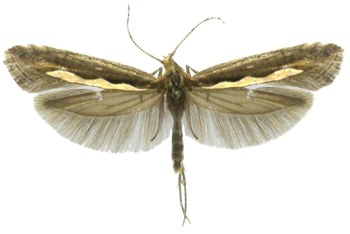Pests
Plutella xylostella (L.) - Diamond-Back Moth.
Systematic position.
Class Insecta, order Lepidoptera, family Plutellidae, genus Plutella.Synonym.
P. maculipennis Curt.Biological group.
Oligophagous pest of vegetable cultures.Morphology and biology.
Wingspan 14-17 mm, length of imago body 5-6 mm. Fore wings narrow, brownish-gray, lighter along anterior margin, with fine dark speckles. Light yellowish-white stripe with wavy edge passes along posterior margin. Hind wings narrow, pointed toward apex, light gray, with wide fringe. Life span on the average 3-4 weeks in females and 2-3 weeks in males. Average fertility is 80-170 eggs, maximum to 300. Fresh eggs yellowish-white, darkening later. Females lay them one by one or by compact groups of 2-5 eggs along veins on the lower side of leaves. Duration of their development is 6-7 days. Body of caterpillars fusiform, bright-green or emerald-green, less often greenish-gray or yellowish; Prothoracic and anal plates with small dark specks. Caterpillars of 1st instar mine leaves from below along the main veins, where they live 3-5 days. Caterpillars of middle instars skeletonize leaves from above, those of the older instars gnaw out roundish windows on the lower side of leaves, remaining upper epidermis untouched. Damage to cabbage is more dangerous in a phase of whorl formation, because the caterpillars injure inner leaflets and upper bud; therefore the head is not formed. Caterpillars moult 3-4 times with duration of each stage 2-3 days; then they pupate; in all their development embraces 35-40 days under favorable conditions. Diapausing pupae winter on cabbage stumps and leaves, on weeds; in the south moths can winter on plant residues.Distribution.
Cosmopolite, meeting in all Europe, in Asia, Africa, America, Australia, New Zealand, on Hawaiian islands; in Central Asia the pest is recorded at height up to 3.5 km a.s.l. In Russia and other FSU countries it is distributed everywhere, where the cruciferous plants grow.Ecology.
Monovoltine in the Far North (Khibiny), bivoltine in Magadan, to 3 generations in middle belt of the European part of Russia, in Baltic countries and in the Far East, to 4 generations in Krasnodar Territory and Ukraine, to 5 in Southern Kazakhstan, to 6 in Transcaucasia, to 10 generations in Central Asia. Moth flight of the wintered generation occurs since mid-June in Karelia and Khibiny, in the beginning of May in middle belt and Cisbaikalia, in the beginning of April in Crimea, the Caucasus, Transcaucasia, and Central Asia. In northern regions the most part of wintering individuals perishes, therefore the 1st generation is usually not numerous and not dangerous. It develops mainly on cruciferous weeds. Cruciferous cultures are damaged by caterpillars of the second and subsequent generations. Complete cycle of development requires degree days sum 390-416°. The lower temperature threshold is 8°C for development of eggs, 5.4°C of caterpillars, and 9°C of pupae. Moths are active usually at twilight and at night, feeding on flowers of cruciferous plants. Moths fly also in the afternoon during mass outbreaks. They are weak flyers, rising up to 2 meters; however, they are passive migrants, being easily transferred by wind over long distances. Entomophages (for example, parasites of caterpillars, Horogenes fenestralis, H. armillata, Apanteles vestalis, A. fuliginosus, and eggs, Trichogramma evanescens) and diseases (e.g., Bacterium prodigiosum) limit the population density.Economic significance.
Caterpillars damage leaves, buds, flowers, and seed-buds of all species of cabbage, and of turnip, rape, swede, garden radish, radish, mustard, horse-radish and other cultural cruciferous crops. Especially strongly harm to cabbage and mustard. Damage also chick-pea and lettuce. Besides they feed on wild cruciferous plants, such as Capsella bursa-pastoris, Barbarea vulgaris, Sisimbrium loeseli and S. sophia, Brassica campestris, Raphanus raphanistrum etc. Control measures include deep autumn plowing, eradication of weeds, treatments of plants by insecticides and biological preparations in the period of caterpillars hatching.Related references.
Adashkevich, B.P. 1972. Biological features of Plutella maculipennis Curt. in conditions of southwest of the USSR. In: Zhuchenko, A.A., ed. Protection of vegetable plants, Collection of papers. V. 12(3). Kishinev: Kartya Moldovenyaske, p. 72- 78 (in Russian).Chistyakov, Yu.A. 1988. Family Plutellidae. In: Kirpichnikova, V.A. & Ler, P.A., eds. Butterflies - pests of the Far Eastern agriculture. Keys. Vladivostok: DVO AN SSSR, p. 53-55 (in Russian).
Gerasimov, B.A. & Osnitskaya, E.A. 1953. Pests and diseases of vegetable cultures. Moscow: Sel.khozgiz. 437 p. (in Russian).
Gershenzon, Z.S. 1974. Family Plutellidae. In: Vasil.ev, V.P., ed. Pests of agricultural crops and forest plantations. V.2. Arthropods. Kiev: Urozhai, p. 231-233 (in Russian).
Marsh, H.O. 1917. Life history of Plutella maculipennis, the diamond-back moth. Journal of Agricultural Research, Washington 10(1): 1-13.
Reikhard, A.N. 1919. Plutella maculipennis Curt. Agricultural monograph. Moscow & Petrograd: Narkozem, 74 p. (in Russian).
Zagulyaev, A.K. Family Plutellidae. In: Kuznetsov, V.I., ed. Insects and mites - pests of agricultural plants. V. 3(1). Lepidoptera. St.Petersburg: Nauka, p. 259-265 (in Russian).


